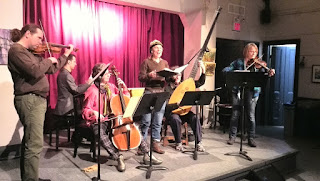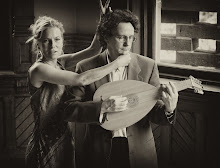A New Year’s Day Concert
Jan. 1&2, 2016
Heliconian Hall
Jan. 1&2, 2016
Heliconian Hall
Sonata Op. 1, No. 12 Arcangelo Corelli (1653-1713)
Grave – Largo e puntato – Grave – Allegro
Costume di grandi Barbara Strozzi (1619-1677)
Sonata Violino e Basso Op. 1, No. 2 Francesco Maria Veracini (1690-1768)
Preludio – Alemanda, Larghetto – Siciliana, Cantabile – Grave – Aria, Allegro
Pièces en F Gaspard Le Roux (c.1660-c.1707)
Prelude – Allemande Grave – Courante – Chacone
Sonata Violoncello e Basso Op. 1, No. 6 Benedetto Marcello (1686-1739)
Adagio – Allegro – Grave – Allegro
Intermission
Sonata a Violino solo Op. 1, No. 13 George Frederic Handel (1685-1759)
Afetuoso – Allegro – Larghetto – Allegro
Sonata da Camera Op. 1, No. 12 – Folia Antonio Vivaldi (1678-1741)
Serenata Con Violini – Hor che Apollo Strozzi
Grave – Largo e puntato – Grave – Allegro
Costume di grandi Barbara Strozzi (1619-1677)
Sonata Violino e Basso Op. 1, No. 2 Francesco Maria Veracini (1690-1768)
Preludio – Alemanda, Larghetto – Siciliana, Cantabile – Grave – Aria, Allegro
Pièces en F Gaspard Le Roux (c.1660-c.1707)
Prelude – Allemande Grave – Courante – Chacone
Sonata Violoncello e Basso Op. 1, No. 6 Benedetto Marcello (1686-1739)
Adagio – Allegro – Grave – Allegro
Intermission
Sonata a Violino solo Op. 1, No. 13 George Frederic Handel (1685-1759)
Afetuoso – Allegro – Larghetto – Allegro
Sonata da Camera Op. 1, No. 12 – Folia Antonio Vivaldi (1678-1741)
Serenata Con Violini – Hor che Apollo Strozzi
The Musicians In Ordinary
Named after the singers and
lutenists who performed in the most intimate quarters of the Stuart monarchs’
palace, The Musicians In Ordinary for the Lutes and Voices dedicate themselves
to the performance of early solo song and vocal chamber music. Soprano Hallie Fishel and lutenist John Edwards have been
described as ‘winning performers of winning music.’ A fixture on the Toronto
early music scene for over 10 years, in 2012 MIO became Ensemble in Residence
at St. Michael’s College in the University of Toronto. They have concertized
across North America and lecture regularly at universities and museums.
Institutions where MIO have performed range from the scholarly to those for a
more general public and include the Shakespeare Society of America, the
Renaissance Society of America, the Shakespeare Association of America, Grinnell
College, the Universities of Alberta, Toronto and at California at San Diego, the
Kingston Opera Guild, Syracuse, Trent and York Universities and the Bata Shoe
Museum. They have been Ensemble in Residence at Lafayette College in Easton,
Pennsylvania.
Patricia Ahern has a BA and BMus from Northwestern University, MMus from Indiana University, and performer diploma from the Schola Cantorum in Basel, Switzerland. She has taught baroque violin at the Freiburg Conservatory and Oberlin’s Baroque Performance Institute, and given masterclasses at McGill, Wilfrid Laurier, York and Grand Valley State Universities, and the Universities of Windsor, Wisconsin and Toronto. She has concertized on five continents performing with Milwaukee Baroque, Ars Antigua, Chicago Opera Theater, Kingsbury Ensemble, Aradia, I Furiosi, Newberry Consort, Musica Pacifica, and the Carmel Bach Festival. Tricia has recorded for Sony, Naxos, and Analekta, and joined Tafelmusik in 2002.
Borys Medicky has appeared as solo harpsichordist and continuo player in the United States, Canada, and Europe. Resident in Toronto, Canada, he is active as a freelance performer, having appeared with major ensembles in Toronto and beyond. He enjoys co-directing (with lutenist Lucas Harris) the Toronto Continuo Collective, an all-continuo ensemble dedicated to fostering an increased interest in the stylish basso continuo accompaniment of seventeenth-century vocal and instrumental music. From 2006-2014 he was the artistic director of the Kitchener-based Nota Bene Baroque Players. He serves as organist of the Fifth Church of Christ, Scientist in Toronto. In addition he builds harpsichords and carries out harpsichord maintenance duties for institutions and private clients in the Greater Toronto area.
‘The tuneful Laura Jones’ (Barczablog) has been praised for performances on all three of her instruments: modern cello, historical cello, and viola da gamba. Her multi-faceted activities include cellist of the Windermere String Quartet, principal cellist of the Talisker Players, assistant principal of the Hamilton Philharmonic Orchestra, and principal cellist/gambist of Nota Bene Baroque Players. Recently she performed the solo viola da gamba part in George Benjamin’s Written on Skin with the Toronto Symphony, and has played to sold-out halls with Ensemble Ritmo Flamenco. She is represented on recordings by The Golden Age of String Quartets, with the Windermere String Quartet; Serenade Française, a CD of music by French composers recorded with her father, pianist Lawrence Jones; and Where Words and Music Meet: Talisker Players at Massey College.
Program Notes
Today, in order to greet the first of the year, we bring you a concert
made up largely of music from the first published works of composers, printed
as their Opus 1’s. Of Corelli’s Op. 1 the amateur musician and critic Roger
North wrote ‘Then came over Corelly's first consort that cleared the ground of
all other sorts of musick whatsoever.’ Corelli’s first sonatas were originally
printed in 1681 in Rome where he worked for the top Cardinal bishops. The
scoring as designated in the Roman partbooks was ‘violino primo, violino secondo, organo’ and ‘violone o arclileuto;’ but in the decades they remained popular
every bass and chordal instrument then used was listed on a partbook somewhere
where the sonatas were printed, from Naples to London. The title page of John
Walsh’s London edition of the early 18th century gives ‘violoncello’ as the
melodic bass and says the ‘through bass’ is for ‘ye organ, harpsichord or
archlute.’ In Bologna the archlute is a theorbo (which you hear today).
In publishing a collection of trio sonatas as his first opus, Vivaldi
imitates Corelli in musical style and choice of scoring. A number of Corelli’s
collections have a ‘ground bass’ as their last piece, and indeed, his sonata we
play today, the last in Op. 1, has a descending ostinato as its ‘Largo e puntado’ movement. Vivaldi gives
us a virtuoso set of variations on the Folia
bass at the end of his debut. The Folia
chord changes are first seen in the E-Z guitar books of the early 17th century
and the charactaristic strumming pattern (strum-STRUMMM-a-strum-strum) can
still be heard in Vivaldi’s and beyond. The string licks are all his own
though.
Handel had worked with Corelli in Rome before settling in London. His
Op. 1 sonatas for a variety of solo instruments were printed at Amsterdam in
the 1720s, but the sonata you hear today, probably composed near the end of his
life, was only numbered as part of that opus by the 19th century cataloguer of
his works. In this, as in the Veracini sonata, you can hear the first
harbingers of the Rococo style, as well as the virtuosity needed to get ‘bums
on seats’ in the new musical world where royal patrons were in decline and
concert goers paid for tickets. Veracini also worked in London in the 1730s and
40s.
Like Handel’s Op. 1, No. 13, whether or not Marcello’s book of ‘cello
sonatas can be called Op. 1 is in doubt, since when they were printed in London
in 1732 they were called Op. 2. Marcello combined composing and performing with
a career in the law and the Venetian government, serving on the Council of 40.
Gaspard le Roux is a man who does
need an introduction, but almost nothing is known of his life except that he
taught harpsichord in Paris. We can be sure that his stylistically very French Pièces de Clavecin of 1705 is his Op. 1 as
it is the only publication he left.
Almost no composers attempt
the Cantata form as their first publishing foray, but we bring, we think, a
first with the great Barbara Strozzi’s Serenata
from her Op. 8. In this piece Strozzi could be said to have arrived at the
Cantata form, where recitatives and arias are split from one another and
instruments provide ritornellos and obbligatos. What a Happy New Form. And a
Happy New Year.
Costume di Grandi
The Customs of the Great
Enjoy them then leave them:
thus inconstant and false
lovers are accustomed to treat
what they hold most dear.
Thus he who lies most,
hopes for most praise.
He cheats and enjoys.
With thieving commands
they rob one’s pleasure.
Despise and enjoy –
thus is the custom of the great.
Thus who steals
hopes for more praise.
He cheats and enjoys.
The great and wise one
is never well-advised
to enjoy and then speak well
of the love he has enjoyed.
Thus he who censures
hopes for more praise.
He cheats and enjoys.
Serenata Con Violini
Hor che Apollo
Now that Thetis rests against Apollo's breast
and my sun is in sleep's lap,
now that I suffer thinking of him,
on whom I may not rest my eyes,
In this refuge, to relieve my pain,
I come crying in love and alone.
Yes, Filli, this heart
that dies of love,
comes in supplication,
in love with your beautiful eyes.
See my foot so heavily shackled
my brightest star,
and if my suffering hurts you so,
be less cruel – or if not, less beautiful;
if less cruel were the suffering of my slavery,
I would know you loved me
and if you were less beautiful, I could elude these bonds.
See with how many thorns my heart
you pierce, red rose,
and when you scorn my misfortune
be less fierce or less fair;
but vent yourselves,
be liberated, sighs of mine,
for I realize now
that I am mocked by Filli even as she sleeps.
She laughs without a doubt at my disquiet
and ignores the pleading of my lament.
I should therefore leave without consolation;
if alive you do not love me,
dead you will see me.
While to another place my steps do take me,
I leave you in sweet forgetfulness,
I am leaving Filli, my soul,
may this be the last goodbye.








